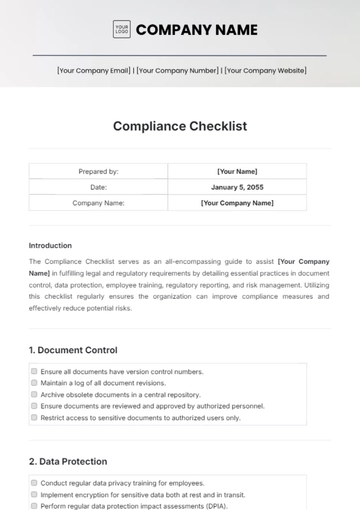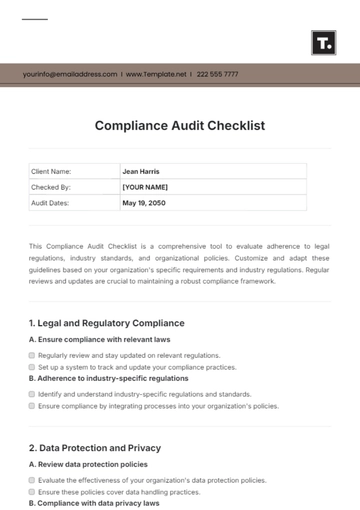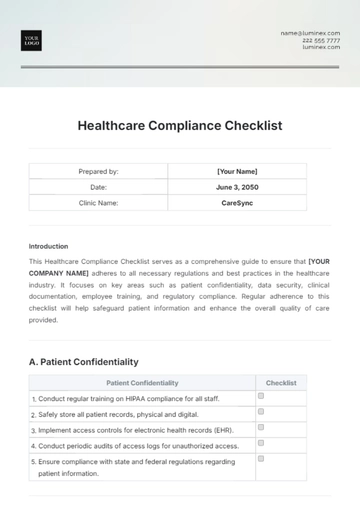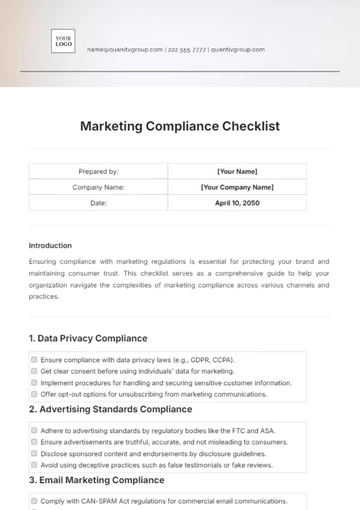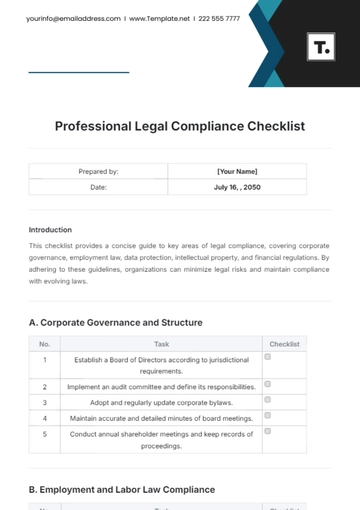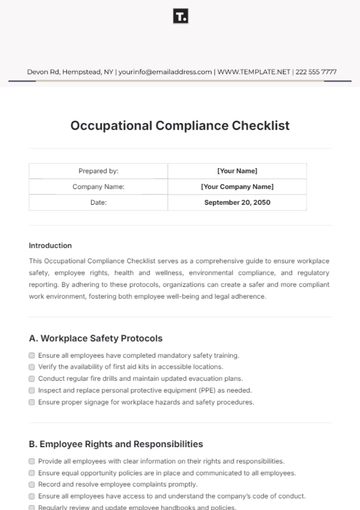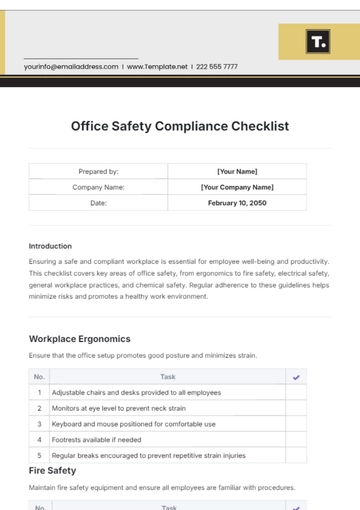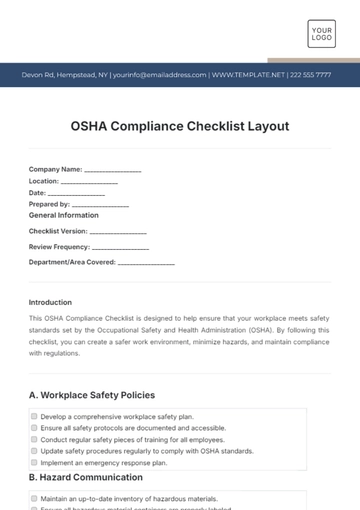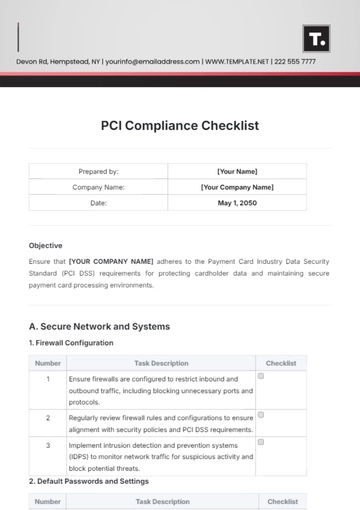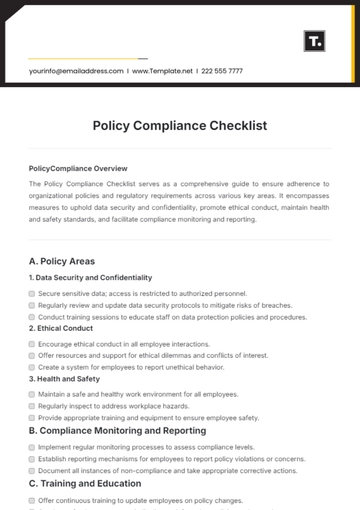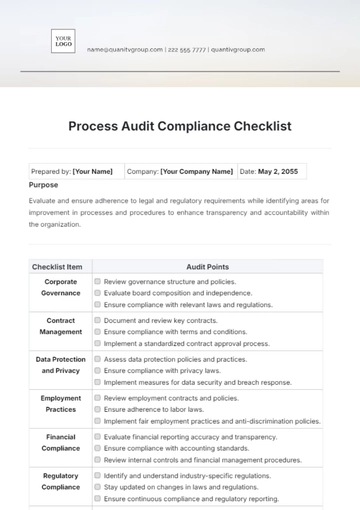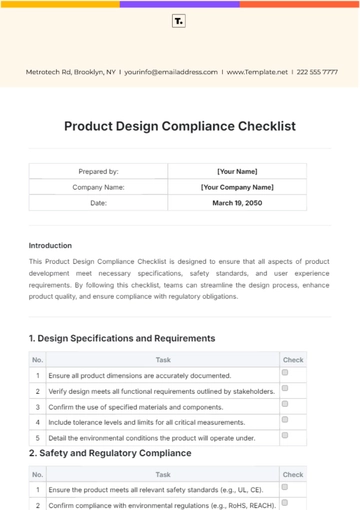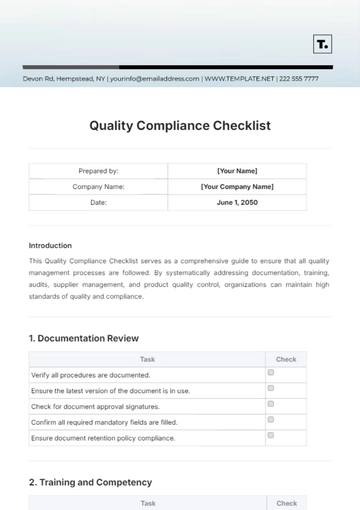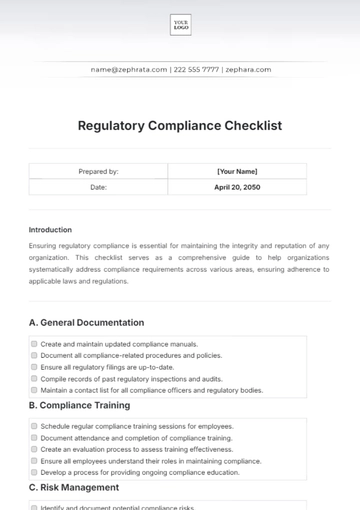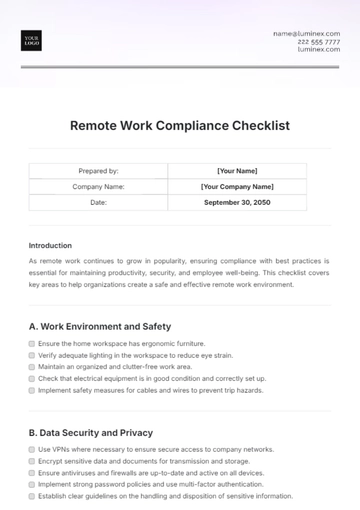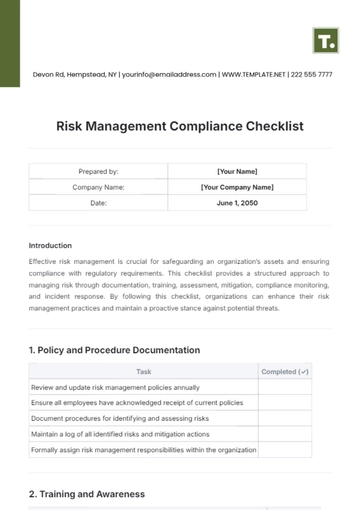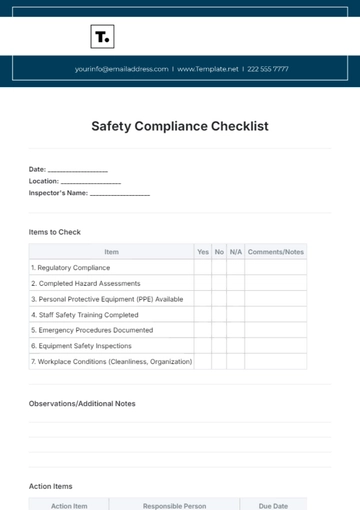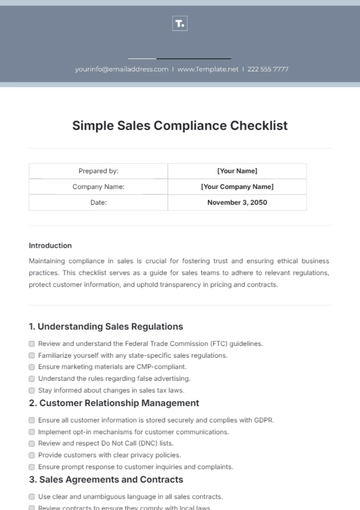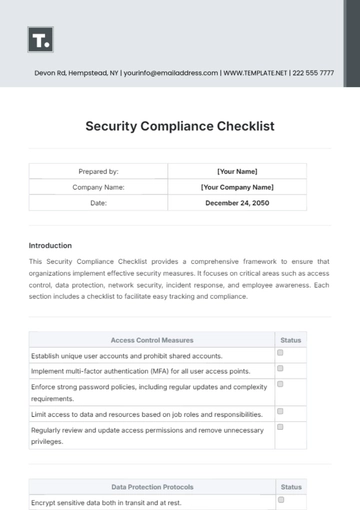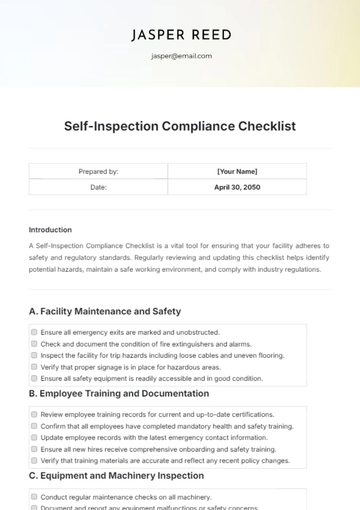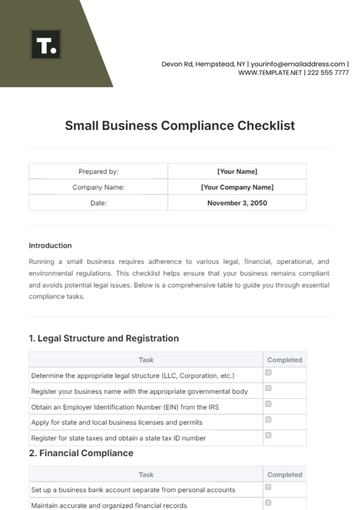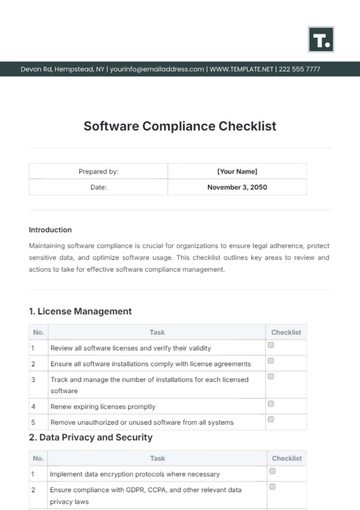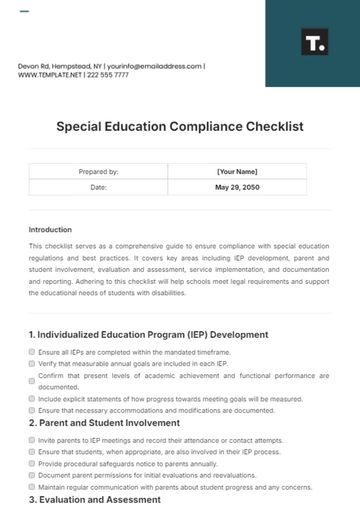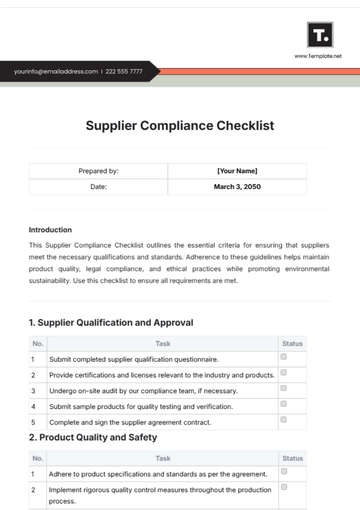Free Privacy Compliance Checklist
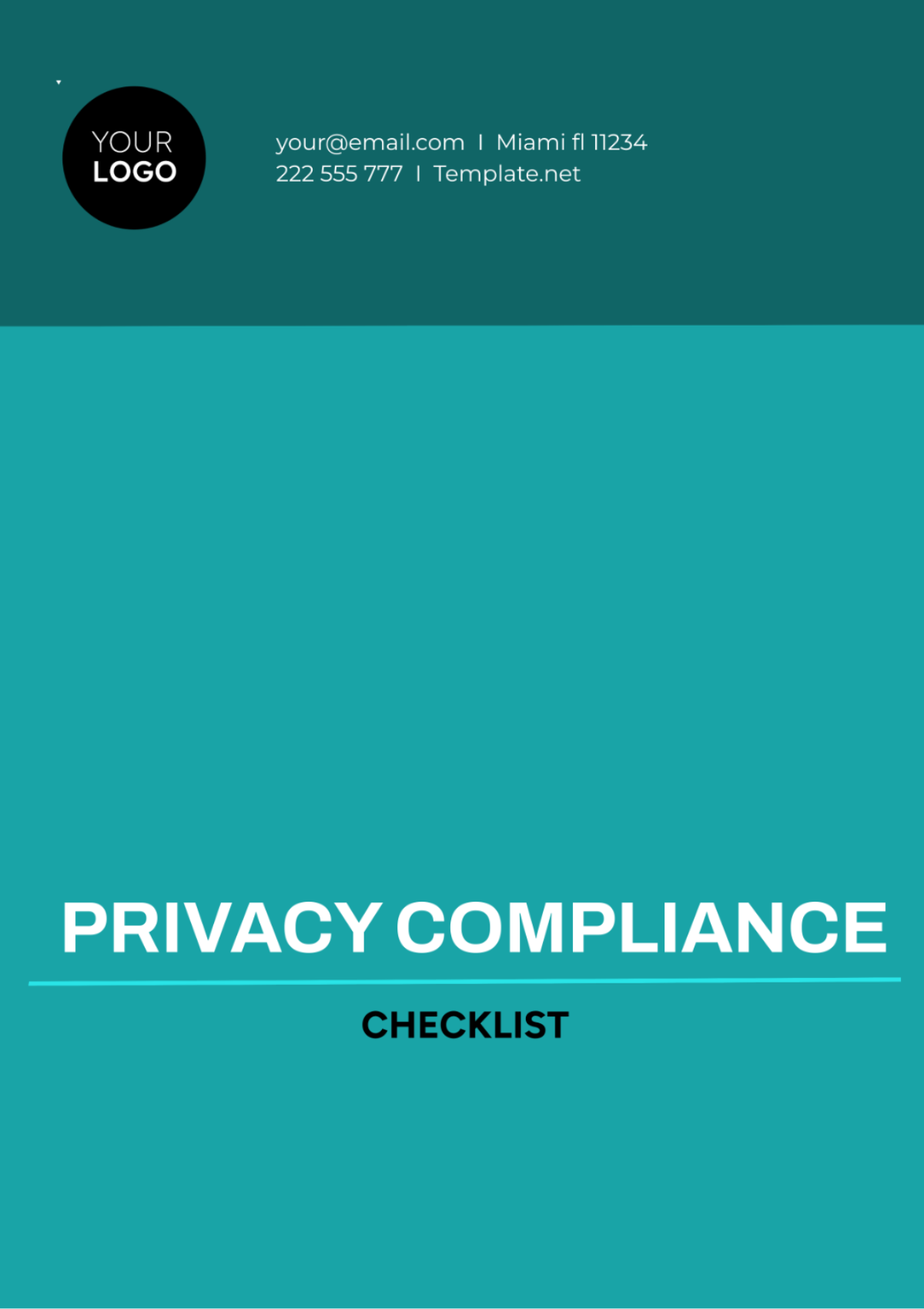
I. Compliance Program Overview
Company Commitment: Clearly state [YOUR COMPANY NAME]'s commitment to privacy compliance.
Responsible Party: [YOUR NAME] [DEPARTMENT]
Date of Last Review: [DATE]
Next Scheduled Review: [DATE]
II. Data Collection and Processing
Data Inventory:
Conduct a comprehensive inventory of all data collected and processed.
Document the types of data collected, sources, and purposes of processing.
Legal Basis:
Ensure that data collection and processing activities have a valid legal basis.
Document consent mechanisms, legitimate interests, or contractual obligations.
Data Minimization:
Review data collection practices to minimize the collection of unnecessary personal data.
Implement measures to limit data collection to what is strictly necessary for the intended purpose.
Transparency:
Provide clear and concise privacy notices to individuals regarding data collection and processing activities.
Include information on data retention periods, data sharing practices, and individuals' rights.
III. Data Security and Protection
Access Controls:
Implement access controls to restrict access to personal data based on job roles and responsibilities.
Regularly review and update access permissions as needed.
Encryption:
Encrypt sensitive personal data both in transit and at rest to protect against unauthorized access.
Ensure encryption protocols comply with industry standards and best practices.
Data Breach Response:
Develop and maintain a data breach response plan to promptly address and mitigate data breaches.
Establish procedures for notifying affected individuals and regulatory authorities in accordance with legal requirements.
Vendor Management:
Assess and monitor the privacy practices of third-party vendors and service providers.
Include privacy requirements in vendor contracts and agreements to ensure compliance.
IV. Employee Training and Awareness
Training Programs:
Provide comprehensive training to employees on privacy laws, regulations, and company policies.
Offer periodic refresher training sessions to reinforce key concepts and updates.
Awareness Campaigns:
Launch privacy awareness campaigns to educate employees about the importance of protecting personal data.
Promote a culture of privacy awareness through newsletters, posters, and other communication channels.
Incident Reporting:
Encourage employees to report any potential privacy incidents or concerns promptly.
Establish a confidential reporting mechanism to facilitate reporting without fear of retaliation.
V. Compliance Monitoring and Auditing
Regular Assessments:
Conduct periodic assessments and audits to evaluate compliance with privacy laws and regulations.
Identify areas for improvement and corrective actions based on audit findings.
Monitoring Tools:
Implement monitoring tools and technologies to track data access, usage, and security incidents.
Monitor system logs and audit trails for any signs of unauthorized access or suspicious activities.
Compliance Reporting:
Generate regular compliance reports to track key performance indicators and metrics.
Present findings to senior management and the board of directors to demonstrate compliance efforts.
VI. Policy Review and Update
Policy Review Schedule:
Establish a regular schedule for reviewing and updating privacy policies and procedures.
Ensure policies remain up-to-date with changes in privacy laws, regulations, and business practices.
Stakeholder Involvement:
Involve key stakeholders, including legal, IT, and business units, in the policy review process.
Solicit feedback and input from relevant departments to ensure policies meet their operational needs.
Policy Communication:
Communicate policy updates and changes to all employees to ensure awareness and understanding.
Provide training or resources to help employees comply with updated policies and procedures.
VII. Record-keeping and Documentation
Documentation Requirements:
Maintain detailed records of privacy compliance efforts, including policies, procedures, and training materials.
Document data processing activities, risk assessments, and incident response actions.
Retention Periods:
Establish retention periods for privacy-related documents and records in accordance with legal requirements.
Safeguard records from unauthorized access, tampering, or destruction.
Auditing and Review:
Conduct regular internal audits and reviews of privacy documentation to ensure accuracy and completeness.
Address any deficiencies or gaps identified during audits promptly and implement corrective actions.
VIII. Signature
This Privacy Compliance Checklist Template provides a comprehensive framework for assessing and managing privacy compliance within [YOUR COMPANY NAME].

[YOUR NAME]
Compliance Officer
[YOUR COMPANY NAME]
[YOUR COMPANY ADDRESS]
Date:
- 100% Customizable, free editor
- Access 1 Million+ Templates, photo’s & graphics
- Download or share as a template
- Click and replace photos, graphics, text, backgrounds
- Resize, crop, AI write & more
- Access advanced editor
Discover peace of mind with the Privacy Compliance Checklist Template from Template.net. This meticulously crafted resource is not only editable but also fully customizable to suit your unique needs. Seamlessly integrate it into your workflow and ensure compliance effortlessly. Editable in our Ai Editor Tool for utmost convenience and efficiency.
You may also like
- Cleaning Checklist
- Daily Checklist
- Travel Checklist
- Self Care Checklist
- Risk Assessment Checklist
- Onboarding Checklist
- Quality Checklist
- Compliance Checklist
- Audit Checklist
- Registry Checklist
- HR Checklist
- Restaurant Checklist
- Checklist Layout
- Creative Checklist
- Sales Checklist
- Construction Checklist
- Task Checklist
- Professional Checklist
- Hotel Checklist
- Employee Checklist
- Moving Checklist
- Marketing Checklist
- Accounting Checklist
- Camping Checklist
- Packing Checklist
- Real Estate Checklist
- Cleaning Checklist Service
- New Employee Checklist
- Food Checklist
- Home Inspection Checklist
- Advertising Checklist
- Event Checklist
- SEO Checklist
- Assessment Checklist
- Inspection Checklist
- Baby Registry Checklist
- Induction Checklist
- Employee Training Checklist
- Medical Checklist
- Safety Checklist
- Site Checklist
- Job Checklist
- Service Checklist
- Nanny Checklist
- Building Checklist
- Work Checklist
- Office Checklist
- Training Checklist
- Website Checklist
- IT and Software Checklist
- Performance Checklist
- Project Checklist
- Startup Checklist
- Education Checklist
- Home Checklist
- School Checklist
- Maintenance Checklist
- Planning Checklist
- Manager Checklist
- Wedding Checklist
- Vehicle Checklist
- Travel Agency Checklist
- Vehicle Inspection Checklist
- Interior Design Checklist
- Backpacking Checklist
- Business Checklist
- Legal Checklist
- Nursing Home Checklist
- Weekly Checklist
- Recruitment Checklist
- Salon Checklist
- Baby Checklist
- Equipment Checklist
- Trade Show Checklist
- Party Checklist
- Hospital Bag Checklist
- Evaluation Checklist
- Agency Checklist
- First Apartment Checklist
- Hiring Checklist
- Opening Checklist
- Small Business Checklist
- Rental Checklist
- College Dorm Checklist
- New Puppy Checklist
- University Checklist
- Building Maintenance Checklist
- Work From Home Checklist
- Student Checklist
- Application Checklist
